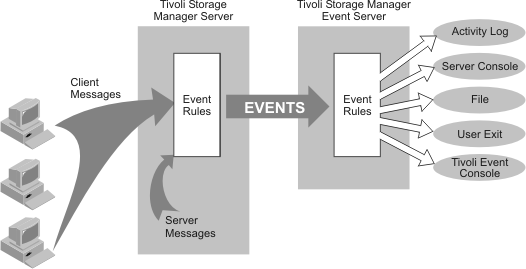One or more servers can send server events and events from their own clients to another server for logging.
About this task

The following scenario is a simple example of how enterprise event logging can work.
- Defines the server that will be the event server. For details
about communication set up, see Setting up communications for enterprise configuration and enterprise event logging.
define server server_b password=cholla hladdress=9.115.3.45 lladdress=1505 - Identifies the server just defined as the event server:
define eventserver server_b - Enables the logging of severe, error, and warning server messages
from the sending server and severe and error messages from all clients
to the event server receiver by issuing the following commands:
enable events eventserver severe,error,warning enable events eventserver severe,error nodename=* - Begins event logging by issuing the following command:
begin eventlogging eventserverThe administrator at the event server does the following:
- Enables the logging of severe and error messages to a file named
events that are sent to it from the sending servers. The administrator
defines the file with the following option in the server options file:
Then the administrator enables the events by issuing the ENABLE EVENTS command for each sending server. For example, for SERVER_A the administrator would enter:fileexit yes events appendenable events file severe,error servername=server_aNote: By default, logging of events from another server is enabled to the event server activity log. However, unlike events originating from a local server, events originating from another server can be disabled for the activity log at an event server.
One or more servers can send events to an event server. An administrator at the event server enables the logging of specific events from specific servers. In the previous example, SERVER_A routes severe, error, and warning messages to SERVER_B. SERVER_B, however, logs only the severe and error messages. If a third server sends events to SERVER_B, logging is enabled only if an ENABLE EVENTS command includes the third server. Furthermore, the SERVER_B determines the receiver to which the events are logged.
- SERVER_A logs to SERVER_B, and SERVER_B logs to SERVER_A.
- SERVER_A logs to SERVER_B; SERVER_B logs to SERVER_C; SERVER_C logs to SERVER_A.